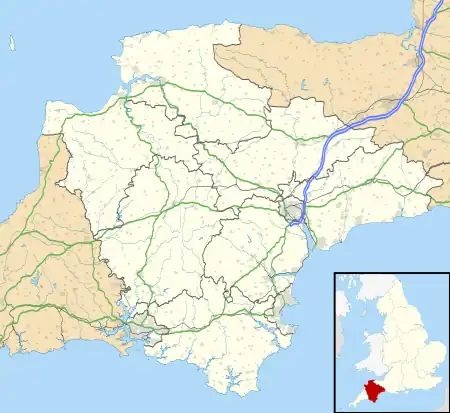| Honeylands | |
|---|---|
.jpg.webp) Front of Honeylands House | |
 Shown in Devon | |
| Geography | |
| Location | Bovey Tracey, Devon, England, United Kingdom |
| Coordinates | 50°43′53″N 3°29′47″W / 50.7314°N 3.4964°W |
| Organisation | |
| Care system | Public NHS |
| Type | specialist |
| Services | |
| Speciality | Tuberculosis, respiratory conditions |
| History | |
| Opened | 1920 |
| Closed | 1987 |
| Links | |
| Lists | Hospitals in England |
The Honeylands, originally the Honeylands Children's Sanatorium and later the Honeylands Children's Centre was a hospital in Exeter, Devon used as a children's pulmonary tuberculosis sanatorium, later used for treatment of children with learning difficulties. Adults were treated at the nearby Whipton Hospital.
History
As a house
The site had a house before 1711, when it was sold by act of parliament upon the death of the owner of Polsloe Barton (which owned the land, despite its proximity to Whipton Barton), Samuel Isaac.[1]
The house passed through various owners, including a doctor, hide broker, and the owner of the Devon and Somerset Store in Exeter High Street.[1]
Tuberculosis sanatorium
In January 1923, the house was purchased by Miss Violet Wills of Torquay, and donated to Exeter City Council for the sole purpose of being used as a sanatorium for children suffering from tuberculosis. Miss Wills offered both the house and the cost of the repairs and adaptations (estimated at £1,000 - £2,000).[1]
It opened and accepted children with TB, in May 1924,[2] as well as those with scarlet fever and diphtheria.[1]
In 1945, a child welfare centre (including ante and post-natal clinics) was built on the grounds of Honeylands.[3]
The hospital joined the NHS in 1948, and along with the larger Hawkmoor Hospital near Bovey Tracey, as well as the nearby adult Whipton Hospital and the City Tuberculosis Dispensary in the city centre, Honeylands formed part of the Exeter Special Hospital Management Committee.[4]

School and learning difficulties
Tuberculosis declined dramatically with the use of antibiotics, and whilst the hospital still took in children for recuperation from illness, they also specialised more on children with learning difficulties. The consultant paediatric doctor worked with Charles and Kay Vranch in 1966 to open Vranch House School on the site on behalf of the Exeter branch of the Spastics Society.[1][5]
The centre offered both residential and community care services to children with "a handicapping condition". By 1982 it offered 30 beds, with 15-20 occupied on a typical night. Facilities were provided on long term as well as short-term respite or even a "babysitting" basis. Around 200 families were users of the service.[6] The service also offered baby and pre-school play groups, parent and family support groups, as well as clinics and specialised primary care for those with challenging conditions.[7]
A new facility called the Brimblecombe Wing was opened in 1971 by HRH Duchess of Kent.[1]
The Honeylands centre was frequently mentioned as an example of best practice management for children with learning difficulties.[8]
Closure
The healthcare facility was closed in 2012, although the Vranch House School remains operational on another part of the site.[9]
References
- 1 2 3 4 5 6 "Honeylands". Exeter Memories. 2019-06-26.
- ↑ "Local News". Exeter and Plymouth Gazette. 1924-05-24.
- ↑ Report of the Medical Officer of Health for 1945. City and County of the City of Exeter. 1945.
- ↑ Annual Report 1948/49. Exeter Special Hospital Management Committee. 1949.
- ↑ Irvine, ED (1966). Annual Report upon the School Health Service. City and County of the City of Exeter. p. 7.
- ↑ Clarke, David (1982). Mentally handicapped people: living and learning. Baillière Tindall. pp. 177–178. ISBN 9780702008948.
- ↑ Brimblecombe, FSW (1982). The needs of parents of young handicapped children living at home. Stress and disability in childhood: the longterm problems: Proceedings of the thirty-forth Symposium. Bristol: Colston Research Society.
- ↑ Gibbons, Jane (1992). The Children Act 1989 and family support: principles into practice. Department of Health. p. 95. ISBN 0113215495.
- ↑ "Derelict children's centre to become care home". Radio Exe. 2022-07-27.